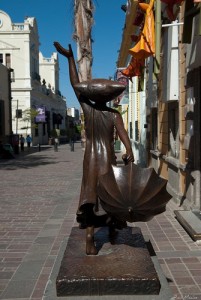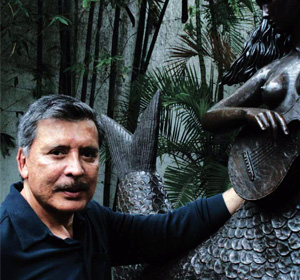Though born in Culiacan, Sinaloa, Mexico, Sergio Bustamante has lived in Tlaquepaque area since early childhood. In his youth, he studied architecture at the University of Guadalajara, but abandoned this pursuit when his talents and interests drew him to the fine arts and crafts.
the “Family Workshop Studio” in Tlaquepaque, Jalisco, Mexico.
Recent Interview: At Pro-Mexico magazine
The making of surreal figures that come out of an egg or look out from a mushroom; suns and moons with rosy cheeks and childish bodies; fountains and nahuales –pre-Hispanic divinities with human face and animal bodies–, has made Sergio Bustamante one of the best known Mexican sculptors since the 1970s.
That idea had made me fear to request an interview with him in his gallery in downtown Tlaquepaque –a small town now part of Guadalajara’s metropolitan area, in Jalisco.
The place is one of the 16 showrooms he has in cities in Mexico, Japan, Uruguay, Russia and the United States. Just to give an idea of Bustamante’s popularity, in the United States his work enlarges the collections of personalities such as Madonna, Dolly Parton and Sylvester Stallone.
The fear to cult figure Bustamante eased down when I entered the gallery terrace, a peaceful place surrounded by gardens and bronze faces that cry water, and because the famous artist turned out to be a nice, smiling, down to earth guy.
 When Bustamante was a young kid, he used to dream himself flying. That might be the reason why many of his characters fly or intend to, sleep or are some sort of celestial creatures. “Last night I had a dream about a dog. The dog was barking and every time he barked an strange force pulled him back and away from me,” Bustamante says with a sense of relief.
When Bustamante was a young kid, he used to dream himself flying. That might be the reason why many of his characters fly or intend to, sleep or are some sort of celestial creatures. “Last night I had a dream about a dog. The dog was barking and every time he barked an strange force pulled him back and away from me,” Bustamante says with a sense of relief.
He was born in the state of Sinaloa, but lives and works in Jalisco. “I have been lucky. I started in the right moment, in the 1970s, in Tonalá [a small town next to Tlaquepaque and equally famous because of its crafts]. Back then almost no one made art-crafts,” he recalls.
He started making papier-mâché. His luck was only starting then. Bustamante began to experiment with bronze and other metals like silver. “I had the same luck with jewelry. Fifteen years ago, when I made my first pieces, there wasn’t much design jewelry in Mexico,” he says.
Artisan, sculptor and jeweler, Bustamante not only makes sculptures, water fountains and jewelry, he is now also creating limited edition shoes, handbags and scarves.
Bustamante’s designs could be shown in fashion shows and red carpets around the world, but he prefers people to buy them out of simple like and pleasure. “Designing is part of my job, the other half is that ideas are executed and pieces are the best quality. But I wouldn’t want to give famous people my pieces to wear.
The pieces speak by themselves, and there are people for whom they mean something. If not, better not to buy them.”
Quality is achieved by a team of 60 artisans and the best raw materials: Mexican silver, bronze, clay, paper paste. If by any chance Bustamante has a big ego, he projects it in the baroque elements of some of his work. Nowhere else. When I ask him if his flying dreams are still the motor that move his work, he tells me that they have been replaced by his readings. When I mention that some of his pieces have been copied and reproduced by Tonalá artisans, he is flattered. Bustamante remembers those times in the 1970s when he learned the techniques from those artisans.
He claims to be happy because some of them can now support themselves by reproducing his designs.
Why do you think the world likes art with such evident Mexican roots?
Mexican style has always been popular. Artisans here are as good as the best artists and jewelry makers in the world. There is a lot of young talent in Mexico.
You have traveled around the world and have galleries and showrooms in other countries. Your work is well known all over the world. What keeps you in the city of Tlaquepaque?
I would have loved to have an atelier in New York or Madrid, but I stayed in Mexico because here is where people know how to make craftwork almost by birth. In Tlaquepaque I have found excellent artisans that it would be difficult to gather in other parts of the world. Another reason is that I take part in every step of the process. This is the right place: Mexico keeps me active because of its people and the quality of their work.
How has your work changed throughout your career?
I keep dreaming, but my dreams have become more realistic. I used to work with papier-mâché and I now use silver, resin and bronze. I make shoes and purses. My work used to have a happier imaginary.
Is it sadder now?
No, I was younger then and my work reflected eternal youth. Now it has turned more introspective. It reflects human feelings and emotions.
What comes next?
Right now I am working in a new collection of “sculpture-jewelry” in silver and resin. It’s made of charms with animal shapes. For 2010 I have a project of baked clay sculptures.
There is no need to wait for Bustamante’s new creations. Like the sculptor’s dreams, his surrealist art is already flying arround the world.


